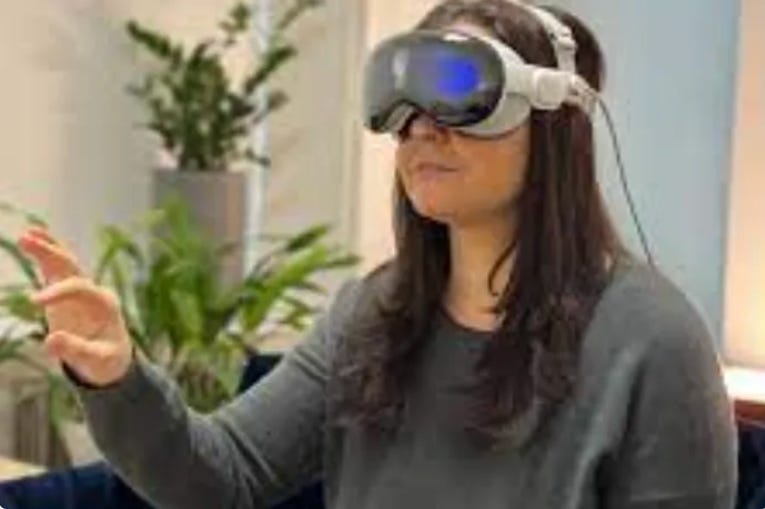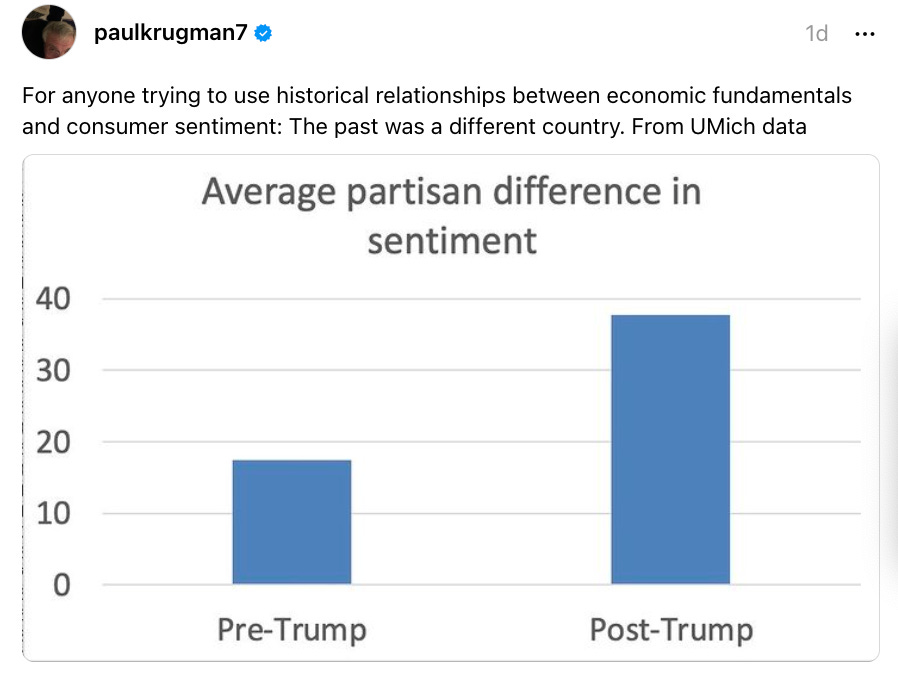BRIEFLY NOTED: 2024-02-12 Mo
Ann Harrison with evidence on capital now a substitute for labor; MOAR New York Times reporters who don’t understand what their job is—or do they?—Nilay Patel on “Spatial Computing”; the climate & plague disasters of the reign of Justinian I; partisan views of the economy; very briefly noted; & Paul Schmelzing on interest rates since 1310; do not prioritize vibes over data!; against the self-image of Alasdair MacIntyre; & BRIEFLY NOTED: for 2024-02-08 Th…
SubStack NOTES:
Economics: I have been asking “where is the evidence that capital investment and labor are now not complements but substitutes?” Well, the evidence is now here:
Ann Harrison: Now is the time to put people before robots: ‘Policymakers must act to ameliorate the impact of automation on incomes…. There is nothing constant about labour’s share…. In the US, the decline in the share of the economic pie going to workers is dramatic…“the great slide”…. Between 1997 and 2019, profits nearly doubled for US-listed companies, from 8 per cent to 15 per cent of revenues. But wages and benefits did not climb as quickly: their share of revenues fell from 27 per cent to 12 per cent, and of value added from 52 per cent to 23 per cent…. In the US, after-tax income inequality is now at its highest level in 40 years…. Possible explanation[s]… globalisation… growing market power of big companies… technological changes that make it easy to replace people with machines…. I explored all three possibilities using millions of data points in Orbis…. The biggest driver is, indeed, the replacement of people with machines, rendering them—from an economic standpoint—obsolete…. A one percentage point increase in research and development expenditure is associated with a two percentage point decline in a company’s labour share… “Disentangling Various Explanations for the Declining Labor Share”…. Policymakers should ensure that tax and subsidy incentives encourage companies to create more, and better, jobs…. Promoting higher educational opportunities at reasonable cost…. Providing stronger social safety nets would prevent US leaders from turning to protectionist measures…. Forward-thinking business schools emphasise the many stakeholders inherent in every business decision, far beyond shareholders and their profits…
<https://www.ft.com/content/d5c9e07b-1278-4815-a9e9-203642a83e09>
Journamalism: Somehow, an awful lot of people very confused about what their job is wind up writing for the New York Times—or maybe not: maybe the purpose of the New York Times is to elect Donald Trump president again to keep the taxes of the Sulzburgers low:
Parker Molloy: What’s Up with the New York Times: ‘New York Times economics reporter Talmon Joseph Smith wrote, “Hung out at a low-key dinner party kind of thing with my girlfriend and some friends. All highly educated. All had no idea what the CHIPS Act was, what the [Inflation Reduction Act] did, or a clear memory of the [American Rescue Plan]. Sure, they’re not swing voters in a swing state, but the Biden Econ team has a LOT of work to do!” When people responded to him by reminding him that he is literally a Times economics reporter, he pushed back on the idea that it was somehow his job to educate the public about various policies, saying that it would amount to “PR” for Biden…. [But] shouldn’t their lack of knowledge send a message to the Times that maybe it isn’t doing enough to educate the public about what’s happening in the world? If stories aren’t sticking in people’s minds, maybe they’re not getting the right placement in the paper, maybe they’re not being written about enough, and so on… <http://readtpa.com/p/whats-up-with-the-new-york-times>
“Spatial Computing”: My take on the Apple visionPro VR headset: Apple has built a very good VR headset at a price/performance sweet spot. It has decided that the principal intended use of the headset is as a simulator of AR glasses that we cannot yet build. The people who are now and will be enthusiasts for the Apple visionPro are and will be those who hypnotize themselves into believing they are wearing the AR headset of five to ten years from now—the one that the current VR headset is simulating. They will be excited, happy, and find multiple use cases. For the rest of us? I think that the immersive video and other entertainment use cases are highly likely to be truly compelling for a slice of the rich. And if you have a use for an environment in which you have a mac computer with eight virtual iPads distributed around it, you will be happy as well. But the crusaders will be those who have fallen under the influence of the reality distortion field, and think they are using not the AR simulator VR headset that is but the AR glasses that may someday be:
Nilay Patel: Apple Vision Pro review: magic, until it’s not: ‘The Apple Vision Pro is the best consumer headset anyone’s ever made—and that’s the problem…. … <theverge.com/24054862/apple-vision-pro-…>
ONE VIDEO: The Mystery of the Dark Age’s Global Climate Disaster:
ONE IMAGE: Republican Partisanship Rules Everything Around Me:
Very Briefly Noted:
Economics: Tim Harford: What the birth of the spreadsheet can teach us about generative AI: Lessons from an earlier software tool that changed the world…. ‘The digital spreadsheet is an example of a technology that automated the more tedious tasks in accountancy, burnishing jobs that were already well-paid and interesting. It may be that generative AI does something similar on a grander scale, letting the humans deal with the big creative questions while the machine handles the nagging details…. It’s that pace of change that gives me pause. Ethan Mollick, author of the forthcoming book Co-Intelligence, tells me “if progress on generative AI stops now, the spreadsheet is not a bad analogy”…<https://www.ft.com/content/c5f7909f-0bac-40fa-b5a8-ff34c38b89a9>
Dani Rodrik: Friday Interview: Doing Industrial Policy Right: ‘Industrial policy is just like any other policy. Yes, it can be inefficient. It can be captured. But that’s not unique. Education policy can be captured by powerful teachers’ unions. Macroeconomic policy can be captured by financial interests. Infrastructure or health policy can be captured by special interests. So that sort of broad-brush generalisation isn’t based on either the economics of industrial policy or the evidence. I think it’s more an ideological predisposition about the role of government…. The economic rationale… is… capturing learning and innovation externalities, offsetting externalities having to do with the disappearance of local jobs, the externalities of the green transition… to providing]… firms with customised services… [that] are… public goods…. The economic rationale for industrial policy is very strong… <https://www.ft.com/unhedged?emailId=559b4998-72f0-4e1c-8532-8b2f4ba97276&segmentId=38af067e-f67a-09ef-7f9d-cb40b4153a58>
Briefing Book… <https://www.briefingbook.info/about>
Preston Mui: The Dream of the 1990s: ‘So far, we have established how full employment, a fixed investment boom, and a secure supply-side provided the conditions necessary for the 1990s productivity boom. We have also shown that we have many of the policy tools necessary for securing productivity growth again today. These conditions can and ought to be reinforced using the fiscal and monetary levers appropriate to each driver… <https://www.employamerica.org/researchreports/the-dream-of-the-90s-part-v/>
Economic History: Fangqi Wen, Erik H Wang, & Michael Hout: Social mobility in the Tang Dynasty as the Imperial Examination rose and aristocratic family pedigree declined, 618-907 CE: ‘Data from the distant past are fertile ground for testing social science theories of education and social mobility. In this study, we construct a dataset from 3,640 tomb epitaphs of males in China’s Tang Dynasty (618-907 CE), which contain granular and extensive information about the ancestral origins, family background, and career histories of the deceased elites. Our statistical analysis of the complete profiles yields evidence of the transition away from an aristocratic society in three key trends: 1) family pedigree (i.e., aristocracy) mattered less for career achievement over time, 2) passing the Imperial Examination (Keju) became an increasingly important predictor of one’s career achievement, and 3) father’s position always mattered throughout the Tang, especially for men who did not pass the Keju. The twilight of medieval Chinese aristocracy, according to the data, began in as early as the mid-seventh century CE… <https://pubmed.ncbi.nlm.nih.gov/38236732/>
Human Capital: Paul H. Buck & al.: General Education in a Free Society… <https://ia804707.us.archive.org/26/items/generaleducation032440mbp/generaleducation032440mbp.pdf>
Web3: Molly White: Review: Chris Dixon’s “Read Write Own”: ‘Prominent crypto venture capitalist Chris Dixon provides an unconvincing bible for blockchain solutionists…. After three chapters in which Dixon provides a (rather revisionist) history of the web… explains… blockchains, and… the types of things one might theoretically be able to do… we are left with… “Here and Now”… precisely four and a half pages long. And rather than name any successful projects, Dixon instead spends his few pages excoriating the “casino” projects that he says have given crypto a bad rap, prompting regulatory scrutiny that is making “ethical entrepreneurs … afraid to build products” in the United States…. Who is this book for? It’s certainly not written to convince the skeptics, for whom Dixon’s disdain is made quite clear. And the dearth of citations or even the briefest of arguments to support the many bold claims Dixon presents as though they are fact suggest it’s not for any but the most uncritical of fence-sitters…. It seems to me that Dixon’s target audience must just be the believers… <https://www.citationneeded.news/review-read-write-own-by-chris-dixon/>
Neofascism: Alasdair MacIntyre (1971): Against the self-images of the age: essays on ideology & philosophy: ‘From this negative character derives both the virtue and the vice of liberalism. The virtue resides in the affirmation of the values of toleration and of freedom of expression; on this matter I stand squarely with the liberal values…. The vice of liberalism derives from the… precepts of liberalism enjoin[ing] upon us certain constraints… but… set[ting] before us no ends to pursue, no ideal or vision to confer significance…. They never tell us what to do. Hence no institution, no social practice can be inspired solely or even mainly by liberalism ; and every institution or social practice that claims to be so inspired—such as the “‘liberal” university or the “liberal” state—is always a fraud… <https://archive.org/details/againstselfimage0000maci_h0j3>
CyberGrifters: Michael Tae Sweeney: ‘There’s basically nothing that Tesla did that Theranos and WeWork didn’t besides keep the fraud going long enough that they were eventually able to scale to viability. Part of the reason Elizabeth Holmes never felt like she did something wrong is that “fake it til you make it” fraud is the template. I often think about the fact that Tesla is the new archetype for high tech startup success, and it has been lousy with fraud for a decade. I think it’s a big part of how we got here. Tesla really does produce a real and profitable product now but even at this stage if they were valued like a car company that makes cars (instead of a “tech company” that makes self driving cars and robots and the other fraudulent stuff) the stock would be worth 1/10th what it is. Theranos blood testing is exactly as viable as Tesla’s autonomous vehicle technology is… <https://bsky.app/profile/mtsw.bsky.social/post/3kkolcio3fs2x>
Cognition: Cecilia Tan: A Novel Is an Empathy Engine: ‘When one person tells a story and another one listens, the activity in the brain of the listener gradually adjusts until it matches the brain activity of the storyteller. The phenomenon has been termed “neural coupling”…. The effect of fiction is more pronounced and longer lasting than nonfiction, and close, immersive reading has a measurably stronger effect than superficial reading…. [Natalie] Phillips observed subjects’ brains lighting up in the areas that correspond to movement and touch. Their brains were reacting as if the readers themselves were in the scenes they read. Immersed…. Immediately after being immersed in fiction, readers feel and behave more empathetically than those who read a piece of nonfiction… <https://www.uncannymagazine.com/article/a-novel-is-an-empathy-engine/>


